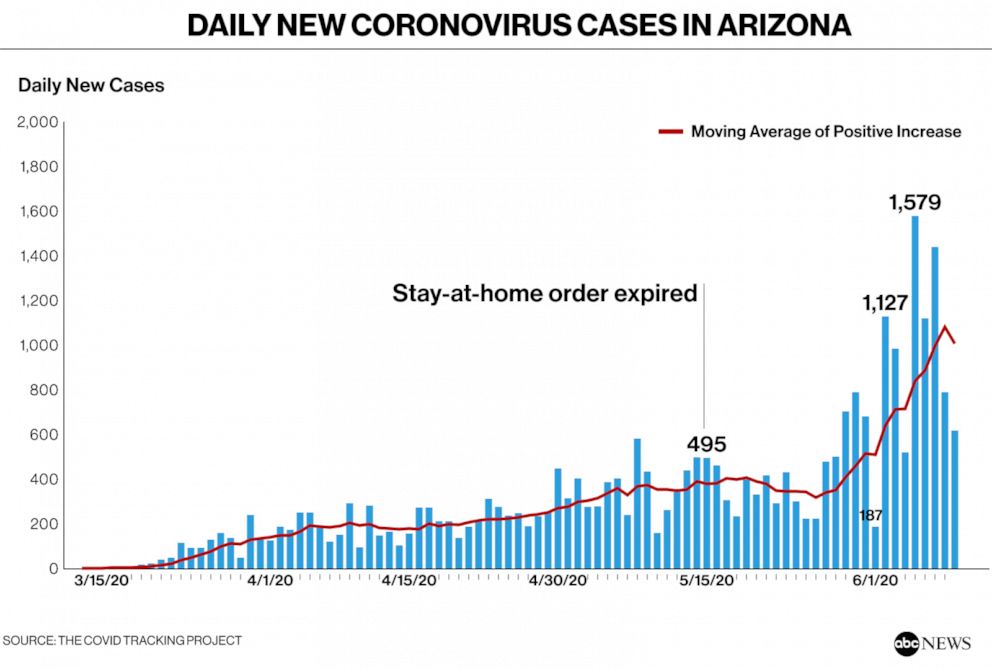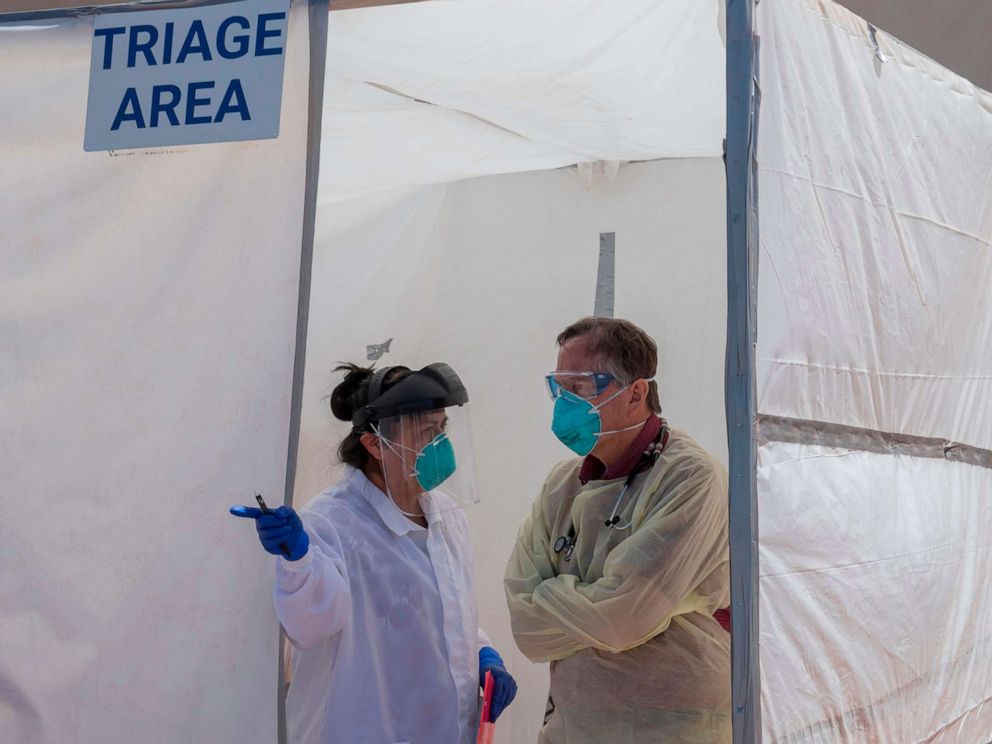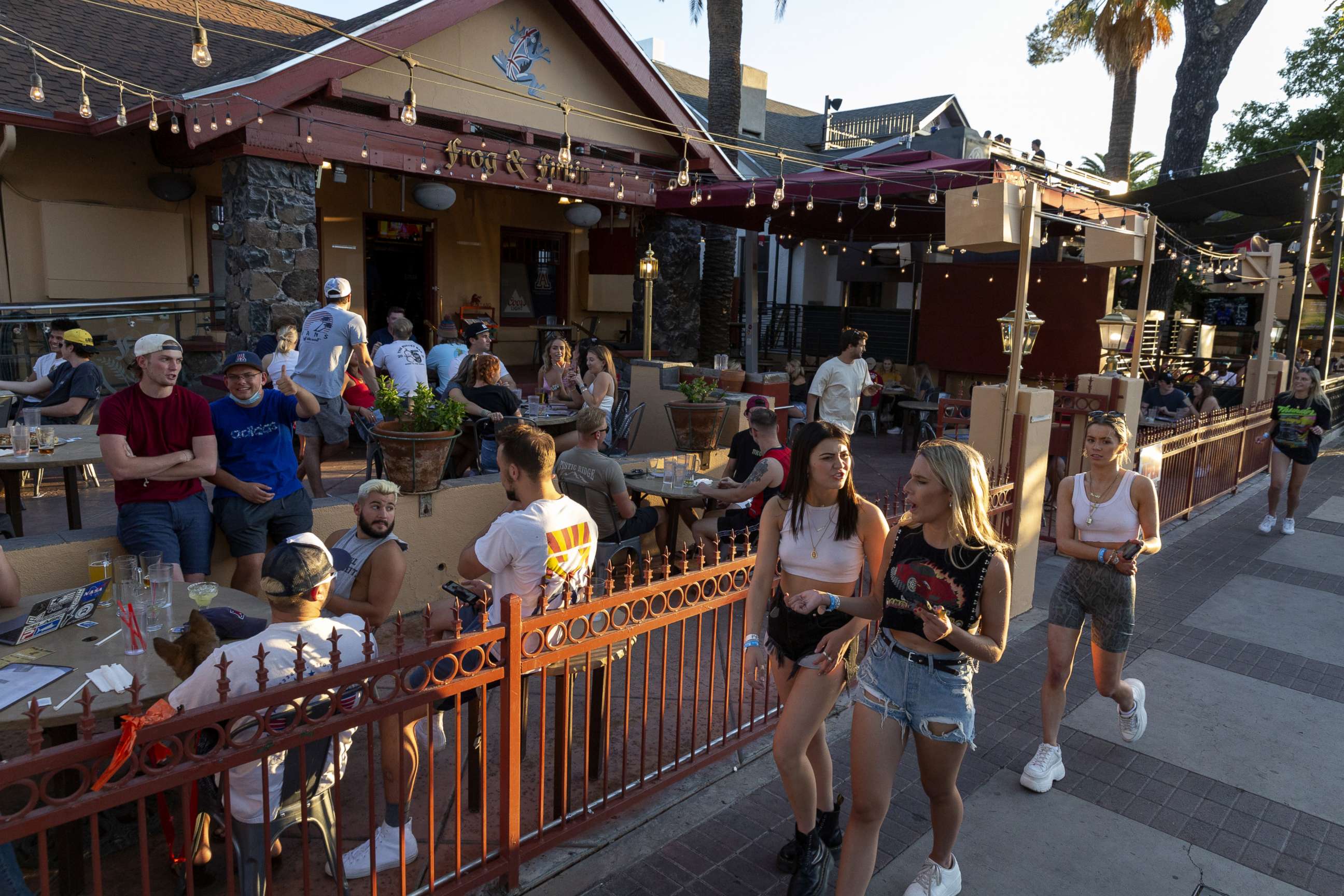Ominous sign? Of the 14 states with rising new coronavirus cases, Arizona has experts especially worried
A pre-pandemic attitude toward social distancing may have lead to the rebound.
As states and cities across the country reopen, some are seeing a worrying rise in new coronavirus cases.
While in most states, new infections remain flat or are decreasing, in 14 states, new cases are growing.
Some states with increasing cases (a growing number over the past 14 days), like Montana, Hawaii and Alaska, have so few overall infections that to label their respective rises a spike would be misleading. Other sharp upticks, like Arizona's, in which new cases rose from roughly 200 infections a day in late May to more than 1,400 infections a day this week, are more ominous.
An ABC News analysis of New York Times data found that new positive cases, hospitalizations and deaths had all increased in Arizona. While testing in the state also increased, so did the rate of positive tests. A high positivity rate can be a sign that a state is only testing its sickest patients and failing to cast a net wide enough to accurately capture community transmission, according to Johns Hopkins University.
The seven-day rolling average for new COVID-19 infections in Arizona, which accounts for fluctuations in cases, was 1,006 cases per day, as of June 9. By contrast, New York, once the epicenter of the coronavirus outbreak in the U.S. and which has nearly triple the population, has a 7-day average of 920 new cases. Hawaii's 7-day average for new cases is 3.

Since increased testing and testing or reporting delays can affect data on new cases, hospitalization rates are a better metric for measuring COVID-19 spikes and surges, experts say.
"We are currently experiencing delays in test results up to a week or more, which means that there may be more positive COVID-19 cases than are currently portrayed here," said Kacey Ernst, an infectious disease epidemiologist at the University of Arizona.
ABC News has found that eight states -- Arizona, Arkansas, Mississippi, North Carolina, South Carolina, Tennessee, Texas and Utah -- are seeing increasing hospitalization for COVID-19.
In Arizona, average COVID-19 hospitalizations have risen 49% from May 26 to June 9, the second-biggest rise of any state during that time period.

In Arizona, "new cases were slowly declining throughout most of May, until the 26th," said Will Humble, executive director of the Arizona Public Health Association, an organization for health professionals and former director of the Arizona Department of Health Services.
"Then there was a bounce-back, where it really starts to ramp up. There’s a rebound effect that began on May 26."
When Republican Gov. Doug Ducey's stay-at-home order expired on May 15, Arizonians returned to gyms, spas, movie theaters, restaurants and bars, without wearing masks in a number of cases. Notably, the expired guidelines weren't replaced by anything rigorous, Humble said. Instead, businesses were encouraged to follow the general Centers for Disease Control and Prevention (CDC) recommendations.
While some businesses and stores enforced those guidelines, for others, Humble said, "it’s pre-pandemic, really."
Since COVID-19's incubation period is believed to be up to 14 days, Humble attributes the spike that began on May 26 to exposures that took place when the stay-at-home orders lifted.
"Then we see a real acceleration just a few days ago that I attribute to Memorial Day weekend," he said.
"People were cooped up. The stay-at-home order was lifted and a bunch of night clubs opened up and got super crowded," he added.
Ernst took a more tempered approach to the factors behind Arizona's rising new cases.
"It is hard to say with certainty," she said, noting that while it's possible localized outbreaks in long-term care facilities are driving the numbers, she suspects it's more likely that loosening state restrictions lead to increased community transmission.
"Many people equate reopening with being safe," Ernst said. "While there is certainly some uptake of masks and physical distancing, it is not ubiquitous."
Ernst also pointed to disparities within Arizona, where the indigenous population is disproportionately being hospitalized for and dying of COVID-19.
"While we are all experiencing a pandemic, it is broken into broad community transmission and many smaller defined outbreaks that have unique circumstances to be addressed. We are not yet in the place where we have well-developed capacity to test and do contact tracing for all of our cases," she said.
"Without these strategies, we will be faced with the need to enact more closures," Ernst added. "The alternative is bleak."
As for the nationwide protests in the wake of the death of George Floyd, it's too soon to say whether the demonstrations will spark additional infections.
"We have yet to see whether those large gatherings will contribute to a spike in cases," Humble said. Because the protests took place outdoors, Humble said he hopes there won't be a big spike. But given the large size of Arizona's demonstrations, he added, "I have no doubt that there has been some case transmission."
Hospitals in Arizona prepare for a COVID-19 surge
As of June 10, Arizona had logged more than 28,000 COVID-19 cases and 1,070 deaths from the disease, according to the Arizona Department of Health Services.
Dr. Sam Durrani, chair of COVID-19 response at Arizona's Honor Care Health System, said that before the May 15 reopening, models predicted that there would only be 600 COVID-19 deaths statewide. Models now predict deaths in the state could top 4,500.
"We're facing a significant chance that we're going to have to shut down the state again," Durrani said, noting that elective surgeries at Honor will likely need to stop. "It's ultimately the governor's decision to do that, but we need to we need to really be socially responsible when we go outside [and need to] socially distance."
"We weren’t ready to reopen," Dr. Matthew Heinz, an internist at Tucson Medical Center, told ABC News. "We hadn't met the criteria set down by the WHO or the CDC to even begin to look at reopening the state, but political leadership pushed us in that direction.”
Proposed gating criteria from the White House included a downward trajectory of cases within a 14-day period or a downward trajectory of case positivity over the same two-week time frame. The percentage of positive tests, for instance, increased from 5% the week of May 3 to 12% the week of May 31.
The Arizona Department of Health Services told ABC News that the department anticipated increased cases in June and is working with public health officials and businesses to mitigate COVID-19's spread.
"As testing continues to ramp up, there will continue to be an increase in cases, and we will continue to monitor the data closely," a health department spokesperson said.
There are no plans for additional rollback measures at this time, according to the governor's office.
Just before the state reopened on May 12, Gov. Ducey said: "Since the start of this pandemic, Arizona has taken a calm and steady approach to protecting health and slowing the spread of COVID-19,” he said. “Today, our hospitals have capacity to provide care to those who need it; our businesses are implementing and adapting to new physical distancing measures."
And on June 4, the governor said the numbers were rising because of testing.
In early June, Heinz was admitting between 3 and 5 COVID cases per day. "It’s just gone up since then," he said. "One thing is to see the numbers on a graph, but I’m seeing these patients in my waiting room," Heinz continued. "After the loosening of some restrictions, we are now seeing a surge in hospitalizations, a surge in ICU usage and of course, unfortunately, a surge in the death rate."

On June 6, the Arizona Department of Health Services sent a letter to hospitals, urging them to activate their facility emergency plans, including suspending elective surgery immediately if they experience staffing shortages.
As of early this week, hospitals in Arizona's nonprofit Banner Health system, which are caring for nearly half of COVID-19 patients in the state, told ABC News that more than 60% of adult ventilators were in use and ICU occupancy was staffed at roughly 85% capacity.
Overall staffing capacity is maxed out at Banner. Despite having available hospital beds and ventilators, if hospitalizations continue to rise at the current rate, there will not be enough staff to care for all of the patients who need treatment, the health organization says.
ABC News' Alyssa Pone, Matt Gutman, Alexandra Dukakis, Soorin Kim, Laura Romero and Olivia Rubin contributed to this report.
What to know about the coronavirus:
- How it started and how to protect yourself: Coronavirus explained
- What to do if you have symptoms: Coronavirus symptoms
- Tracking the spread in the U.S. and worldwide: Coronavirus map
Tune into ABC at 1 p.m. ET and ABC News Live at 4 p.m. ET every weekday for special coverage of the novel coronavirus with the full ABC News team, including the latest news, context and analysis.




